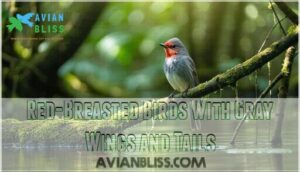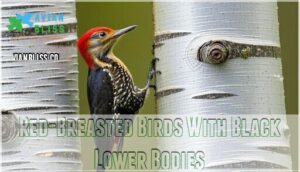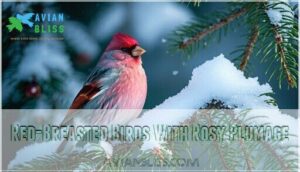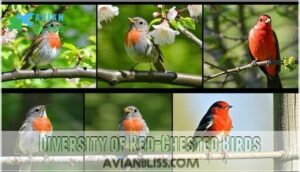This site is supported by our readers. We may earn a commission, at no cost to you, if you purchase through links.
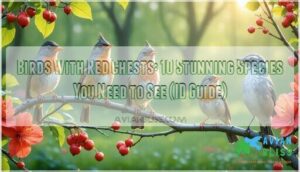
These striking species include House Finches with rosy-pink chests, Red-breasted Nuthatches with cinnamon underparts, and Rose-breasted Grosbeaks displaying bold triangular patches.
Each species shows distinct patterns—some sport black heads, others gray wings, and many combine red chests with contrasting plumage that creates stunning visual displays.
The intensity ranges from subtle peachy tones to vibrant crimson, making identification both challenging and rewarding for bird enthusiasts seeking these colorful treasures in diverse habitats.
Table Of Contents
- Key Takeaways
- Red-Breasted Birds With Dark Wings
- Red-Breasted Birds With Black Heads
- Red-Breasted Birds With Gray Wings and Tails
- Red-Breasted Birds With Black Lower Bodies
- Red-Breasted Birds With Rosy Plumage
- North American Red-Chested Birds
- Birds With Unique Chest Colors
- Red-Chested Birds in North America
- Birds With Red Chest Markings
- Diversity of Red-Chested Birds
- Frequently Asked Questions (FAQs)
- What are the little brown birds with red chests?
- What bird has a red patch on its chest?
- What is a small GREY finch with red breast?
- How do red-chested birds produce their vibrant coloration?
- Are there any completely red birds in existence?
- Are there any aquatic birds with red chests?
- What causes red chest coloration in birds?
- Do female birds have red chests too?
- When do red-chested birds migrate south?
- How do red-chested birds build their nests?
- Conclusion
Key Takeaways
- You’ll encounter over 30 red-chested bird species across North America, from common American Robins with orange-red breasts to brilliant Northern Cardinals with vibrant crimson plumage.
- You can identify different species by contrasting features – Rose-breasted Grosbeaks display black heads with red triangular patches, while Red Crossbills show dark wings against their red chests.
- You’ll find these birds in diverse habitats ranging from dense coniferous forests (Pine Grosbeaks) to suburban backyards (House Finches), with each species adapted to specific environments.
- You’ll notice their red coloration comes from carotenoid pigments in their diet of berries, seeds, and insects, with males typically showing brighter colors than females for matting displays.
Red-Breasted Birds With Dark Wings
The contrast between fiery chests and shadowy wings creates nature’s most striking color combinations.
You’ll find these redbreasted birds showcase dramatic Wing Coloration patterns that make bird identification easier.
The Red Crossbill displays this perfectly with its dark red chest against black wings while inhabiting coniferous forests.
Specialized bills and dramatic plumage make these forest dwellers nature’s most striking seed-crackers.
Their specialized crossed bills help them extract seeds from pine cones – a unique Diet Variation among red plumage species.
Rose-breasted Grosbeaks show jet-black heads with brilliant red chest patches and prefer forest edges.
These birds with red chests exhibit different Flight Patterns – crossbills undulate through treetops while grosbeaks fly more directly between perches.
Most species maintain stable Conservation Status though habitat loss affects some populations.
Their Habitat Preference ranges from dense woodlands to suburban parks.
Each bird species adapts its feeding behavior to available food sources making them fascinating subjects for observation.
Some males display vibrant red epaulets for mating.
Red-Breasted Birds With Black Heads
Among red-chested songbirds, black-headed varieties create striking color contrasts that catch every birdwatcher’s eye. The Rose-breasted Grosbeak stands out as the champion of this group. You’ll spot its jet-black head paired with brilliant red chest patches in forests and parks across North America.
This medium-sized bird breaks the typical seed-eating pattern of most grosbeaks. Grosbeak diet includes insects during breeding season and seeds in winter. Their thick cone-shaped bills handle both food types easily.
Cardinal range overlaps with grosbeaks in some areas but cardinals lack black heads. When doing red chest bird identification, look for the grosbeak’s white belly and wing bars. Males show the brightest colors while females appear brown and streaky.
These redbreasted birds prefer dense woodland edges where they build cup-shaped nests. Their sweet warbling song helps with bird identification even when you can’t see them clearly through thick foliage. Conservation efforts seek to protect grosbeak populations and their habitats.
Red-Breasted Birds With Gray Wings and Tails
Several Gray Winged Species showcase stunning Tail Color Variation that’ll captivate any bird watcher. The Vermilion Flycatcher stands out with its brilliant red head and chest contrasting beautifully against soft gray wings and tail feathers.
These small red breasted birds prefer wetland Habitat Preferences across South and Central America. You’ll spot these agile hunters perching on branches while scanning for insects.
Their Diet Specifics focus entirely on catching flying insects mid-air. Unlike many north american red breasted birds, Vermilion Flycatchers thrive in tropical climates where their Conservation Status remains stable.
The red-breasted merganser, another bird with a red chest, is known to dive for fish. The dramatic color combination makes bird identification straightforward.
Their red plumage appears almost luminous against the muted gray flight feathers. When you see one darting from perch to perch, you’ll understand why these red breasted bird species rank among nature’s most striking examples of contrasting coloration in the avian world.
Red-Breasted Birds With Black Lower Bodies
After exploring birds with gray wings and tails, you’ll find another striking group: red-breasted bird species with bold black lower bodies. The Red-Breasted Sapsucker stands out as the star of this category.
This Sapsucker Identification is straightforward – look for vibrant red covering the head, neck, and chest that contrasts sharply with jet-black lower body plumbing.
Sapsucker Behavior differs from typical woodpeckers since they drill neat rows of holes to access tree sap rather than hunting insects.
Sapsucker Diet focuses primarily on tree sap, though they’ll also eat insects and berries. Sapsucker Habitat includes wooded areas with hemlock, aspen, and pine trees where they can easily access sap sources.
The similar sounding red breasted nuthatch also inhabits these forests. Sapsucker Nesting occurs in dead trees where pairs excavate cavities.
These birds with red plumage represent one of the more unique types of redchested birds you’ll encounter. While not as common as cardinals, they’re worth seeking out during your next woodland adventure.
Red-Breasted Birds With Rosy Plumage
Looking beyond solid black bodies, you’ll discover birds with red chests that show stunning rosy plumage throughout their feathers. The Pine Grosbeak exemplifies this beauty with its soft pink-red coloring that seems to glow in sunlight. These red breasted finches display remarkable plumage variation between males and females.
You’ll spot Pine Grosbeaks in mountain coniferous forests across North America. Their habitat preference includes spruce and fir woodlands where they feed on seeds and buds. This rosy diet of pine seeds gives their feathers that distinctive warm tone.
During winter months, these red breasted songbirds form small flocks and venture into backyard feeders. Their breeding habits involve males showing off their vibrant chest patches to attract mates in early spring. Red breasted mergansers, another species with a red chest, are known to dive for fish.
Here’s what makes these birds special:
- Their gentle pink glow creates a sunset effect against snowy branches
- Males sing sweet warbling songs that echo through quiet forests
- Their calm nature lets you observe them closely at feeders
Unlike the sharper contrast of rosebreasted grosbeak markings, Pine Grosbeaks show gradual color shifts from deep rose to pale pink.
North American Red-Chested Birds
North American forests host more than 30 species with striking red chest coloration. You’ll find these vibrant birds across diverse habitats from Mexico to northern Canada.
Northern Cardinals dominate suburban areas with their brilliant red plumage and distinctive black face masks. Rose-Breasted Grosbeaks showcase dramatic red triangular patches against jet-black heads. The American Robin remains our most abundant red-chested species with over 300 million individuals continent-wide.
One might also find birds with red on their faces, such as the Pyrrhuloxia’s red face.
Mating Displays peak during spring when males exhibit their brightest red coloration for territory marking. Regional Distribution varies substantially – Vermillion Flycatchers prefer southwestern riparian zones while House Finches thrive in urban environments.
| Species | Primary Habitat | Conservation Status | Key ID Feature | Range |
|---|---|---|---|---|
| Northern Cardinal | Suburban areas | Stable | Bright red crest | Eastern US |
| American Robin | Urban/suburban | Abundant | Orange-red breast | Continent-wide |
| Rose-Breasted Grosbeak | Deciduous forests | Declining | Red triangle patch | Eastern/Central |
| House Finch | Cities/towns | Stable | Rosy-red face | Widespread |
| Vermillion Flycatcher | Riparian areas | Vulnerable | Brilliant red head | Southwest |
Conservation Status varies dramatically – while robins thrive, species like Red Siskins face extinction from habitat loss and illegal pet trade.
Birds With Unique Chest Colors
The realm of red-chested birds showcases fascinating color mutations and regional variations that make bird identification guide experiences unforgettable.
You’ll discover birds with orange chests like the Elegant Trogon, whose orange-red belly contrasts sharply with its dark green breast and white chest band.
Diet influence and light exposure create stunning bird plumage colors in species like the White-winged Crossbill, where males display rose-red heads and underparts.
These unique bird colors result from hybridization effects and environmental factors, making birdwatching endlessly rewarding.
Eastern Bluebirds, for example, thrive in open habitats, showcasing distinct habitat preferences.
Red-Chested Birds in North America
You’ll discover an impressive variety of North American birds sporting brilliant red chests across diverse landscapes from Alaska to Mexico. These crimson-breasted species showcase remarkable Habitat Variation, thriving in everything from dense coniferous forests to suburban backyards.
Northern Cardinals brighten winter feeders with their vibrant plumage, while Rose-Breasted Grosbeaks prefer deciduous woodlands during breeding season. The elegant trogon, though rarer, also displays a vibrant orange-red belly.
Identification Tips become essential when distinguishing between similar species:
- Vermilion Flycatcher males display fiery red heads and chests with dark wings
- Red Crossbills show specialized bills for extracting conifer seeds
- American Robins feature rust-colored breasts with darker heads
- Painted Buntings combine red underparts with blue heads in males
- Scarlet Tanagers present solid red bodies with black wings during breeding
Regional Differences affect distribution patterns substantially. Western species like Hepatic Tanagers inhabit mountain pine-oak forests, while eastern varieties prefer mixed hardwood habitats. Many species exhibit striking Mating Displays where males showcase their brilliant red coloration.
Conservation Status varies widely among North American birds, with some thriving while others face population declines. Some birds, like the Northern Flicker, have red cheek markings.
Birds With Red Chest Markings
Birds with red chests display remarkable Chest Color Variation that serves essential survival functions.
You’ll notice Red Crossbill males show deeper red in colder climates, while Rose-Breasted Grosbeak maintains consistent markings across regions. Habitat Influence affects coloration intensity – forest species like Scarlet Robin often display brighter hues than their open-area relatives.
Their diet often includes seeds, berries, and insects, influencing their vibrant plumage.
- Reddish Bird Identification becomes easier when you understand these color patterns vary by season and age
- Red-Chest Bird Behavior includes using bright plumage for territorial displays and mate attraction
Plumage and Diet connect directly – seeds rich in carotenoids enhance the vibrant colors you see on robin redbreast and similar species.
Diversity of Red-Chested Birds
From recognizable backyard visitors to rare tropical gems, red-chested species showcase remarkable bird species diversity across the globe.
These birds demonstrate fascinating coloration evolution and habitat variation that spans continents.
Their geographic distribution reveals how reddish plumage adapts to different environments.
The plumage of some species, such as the Red Whiskered Bulbul, also features red cheek patches.
| Species | Primary Habitat |
|---|---|
| American Robin | Urban parks and gardens |
| Scarlet Tanager | Deciduous forest canopy |
| Painted Bunting | Woodland edges and thickets |
| Vermilion Flycatcher | Open savannas and farmlands |
Conservation status varies widely among these species.
Some thrive in human-modified landscapes while others face declining populations due to habitat loss.
Frequently Asked Questions (FAQs)
What are the little brown birds with red chests?
You’ll spot House Finches most often – small brown birds with males showing rosy-red chests and faces. Purple Finches also fit this description, displaying pinkish-red coloring on their brown bodies.
What bird has a red patch on its chest?
You’ll find several species with distinctive red chest patches.
The Rose-breasted Grosbeak shows jet-black head with bright red triangular patches.
Northern Cardinals display vibrant red plumage with black face markings throughout North America.
What is a small GREY finch with red breast?
Like a tiny jewel against winter’s canvas, you’re spotting a House Finch.
Males display rosy-red breasts contrasting with brownish-gray bodies.
They’re common backyard visitors across North America, feeding on seeds and frequenting feeders year-round, making them a delightful year-round presence.
How do red-chested birds produce their vibrant coloration?
You’ll discover that red pigments come from carotenoids in their diet – fruits, berries, and seeds. Their bodies convert these compounds into brilliant reds through specialized feather structures.
Are there any completely red birds in existence?
Yes, you’ll find several completely red birds in nature.
Northern Cardinals showcase brilliant red plumage across their entire bodies, while Summer Tanagers display solid red coloring throughout their feathers during breeding season.
Are there any aquatic birds with red chests?
You’ll rarely spot aquatic birds flaunting crimson chest feathers in wetland sanctuaries.
Most water-loving species sport earth tones for camouflage.
However, you might glimpse Vermillion Flycatchers near South American wetlands with their striking red chests.
What causes red chest coloration in birds?
Red chest coloration comes from carotenoid pigments you’ll find in their diet.
Birds can’t make these colorful compounds themselves, so they absorb them from berries, insects, and seeds they eat daily.
Do female birds have red chests too?
Surprisingly, most females don’t sport the flashy red chests you’d expect.
Female birds typically display muted browns and grays for camouflage while nesting, though some species like Northern Cardinals show subtle reddish tinges.
When do red-chested birds migrate south?
Migration timing varies by species and location. Most red-chested birds like American Robins migrate between August and October when temperatures drop and food becomes scarce in northern regions.
How do red-chested birds build their nests?
Like master architects, red-chested birds weave twigs and materials into cup-shaped homes.
You’ll find them selecting branches, bark strips, and soft materials to create sturdy nests in tree forks or shrubs.
Conclusion
Spotting birds with red chests becomes like collecting nature’s ruby treasures once you know where to look.
You’ll find these vibrant species across diverse habitats from woodlands to suburban gardens.
Each red-breasted bird offers unique identification markers through wing patterns and head colors.
Keep your binoculars ready and field guide handy.
The rewarding challenge of distinguishing subtle differences in plumage will sharpen your birding skills while connecting you deeper with avian diversity.

